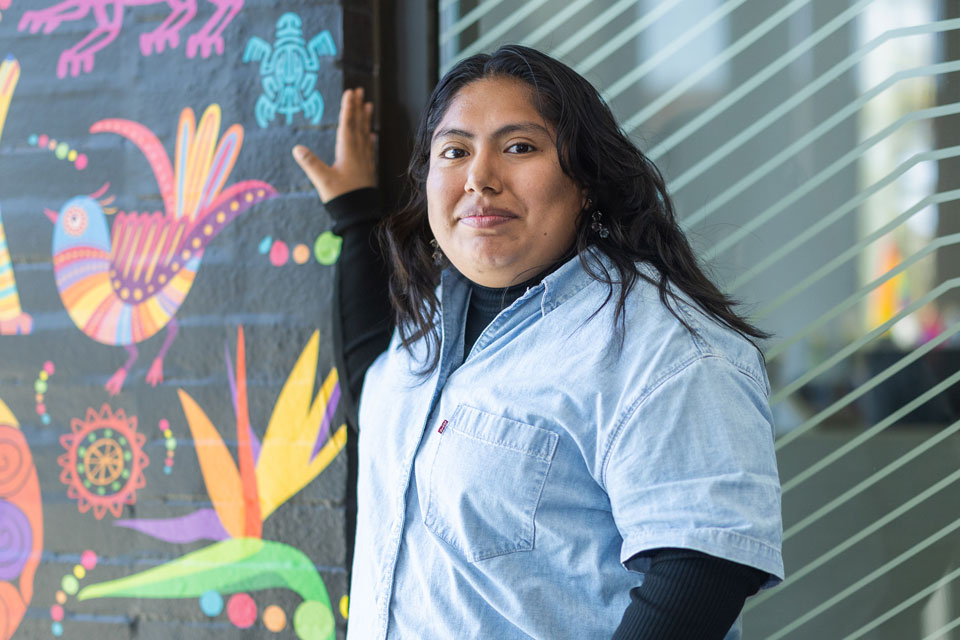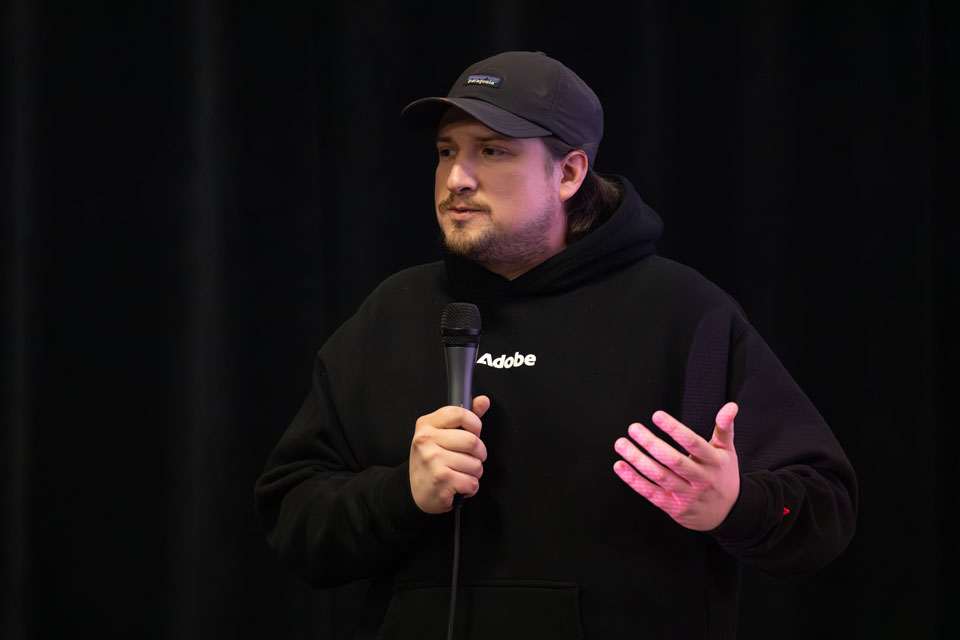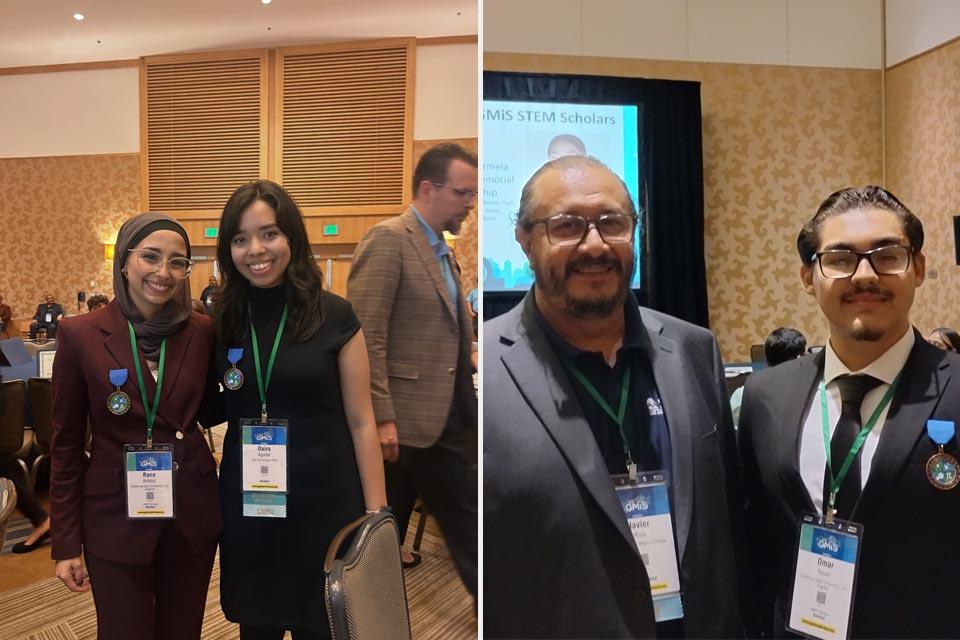Strangers come up to Maria Velasco and tell her how proud they are of her and her work in promoting their indigenous Zapotec language. Her fellow Oaxacans approach her on the streets of Koreatown and share stories of how their children or grandchildren have learned Zapotec words and phrases through Velasco’s online videos and social media posts.
Velasco has become an influencer for Zapotec.
Pride in Zapotec was not instilled in Velasco in her formative years. Her parents dissuaded her from learning the language, believing the Spanish language was all she needed to advance through life, and that the ancient language of their southern Mexican state of Oaxaca was no longer of value in modern-day Mexico and would soon be obsolete.
Today, the 25-year-old Velasco is working to keep Zapotec alive and relevant through her graduate studies in linguistic anthropology at Cal State LA. Preserving the language, she says, means preserving the culture.
“When most people talk about Mexico before colonization, they talk about Aztecs, but there are also Zapotecs, Incans, and a lot of other indigenous languages that a lot of people don’t know about,” Velasco said. “And I’m just trying to push on social media and say, this is who we are, this is how we speak. If you ever go to Oaxaca and see our indigenous community, this is the type of clothing we wear, this is the food we eat. It’s important to share the language, the culture.”
Velasco is still formulating the minute details of her graduate project, but the aspiring documentarian filmmaker plans to compare and contrast the lives of Zapotec speakers in her hometown of San Francisco Yatee and Koreatown, the neighborhood she has called home since the age of 5.
At Cal State LA, she also works with the Language Documentation + Revitalization Space (LADORES) research group, led by Aaron Sonnenschein, professor and chair of anthropology, and has assisted with the creation of more than 200 Zapotec word-of-the-day videos and a representation of the official regional alphabet.
There are approximately 7,000 languages spoken around the world, the majority of which are in danger of being completely forgotten by the end of the century, according to Sonnenschein. He says speakers of endangered languages are now likely in their 40s and older, and they face systematic and individual modern-day obstacles in passing along their languages to their children.
“By 2100, at least half of the world’s languages are no longer going to be spoken,” he said. “Parents stop using the language because oftentimes they have face discrimination because of the language and the identity of being indigenous. There is still this myth of the shoeless, illiterate, indigenous person.”
As a child, Velasco had subscribed to her parents’ attitude toward the language. After moving to the United States, learning and mastering English, like Spanish before it in Mexico, became the priority. Velasco would shrink when she would hear her mother speak Zapotec in buses, at mom-and-pop stores, and on the streets. Growing up in Koreatown, she was more interested in learning the Korean language.
But Zapotec had always been a part of her life. She heard her parents speak it, mixed in with their Spanish, daily. Additionally, Velasco says many Oaxacan merchants living and working in Koreatown, mostly from generations that preceded hers, communicate with customers through Zapotec.
But Velasco says it was never spoken to her directly. She understood enough Zapotec words, but she never spoke it, much less read or write it with any expertise.
Video: Cal State LA graduate student Maria Velasco keeps indigenous Mexican language Zapotec alive.
Her interest in the language grew as an undergraduate student at Cal State Northridge when she enrolled in a class on Mexican history, thinking she would learn about Mexican Independence Day, the Mexican Revolution, and other historical milestones that defined the country.
“That was not the case,” Velasco said. “The instructor showed us manuscripts of Zapotec from the 16th, 17th centuries. I read them and thought, I know what this is. That’s when I immersed myself more into the Zapotec.”
The professor of the class, Xochitl Flores-Marcial, would serve as Velasco’s mentor, and the two of them, along with other students, collaborated on various projects.
Velasco helped translate centuries-old Zapotec manuscripts from the Colonial Valley region for the Ticha website, which also features a searchable dictionary for Zapotec words. She filmed and edited a number of videos about the project, and she was also among the co-authors of the Caseidyneën Saën teaching material.
She graduated from Northridge in 2021 with a bachelor’s degree in history with a minor in art history. Her accomplishments at Northridge caught the attention of Sonnenschein, who recruited Velasco to continue her work as a graduate student at Cal State LA.
“She sees the importance of making the language more visible,” Sonnenschein said. “Her work is important in that it opens up all these spaces—academia, the activist world, entertainment—where the language can be used and shared. Her work has the potential to be very transformative.”
The first thing Velasco wants to impress about Zapotec is that it is a language of its own, and not a regional dialect of Spanish.
“Even some of our paisanos (compatriots) will argue that it’s a dialect,” she said. “It’s always been a language because it has its own writing system. It has its own alphabet.”
For the past six months, Velasco has been taking Zapotec classes through Zoom with Florentino Ambrosio, a teacher from San Francisco Yatee. Her goals are to become more conversational and to improve in writing and reading the language.
“Promoting it on Instagram or TikTok or YouTube is the best way to immerse people into the language,” she said. “I feel proud and happy when someone recognizes my work. If I get a like on a post, or a share, I know it’s spreading. It’s fulfilling.”
Velasco’s work has inspired others, both young and old, to learn the language and take pride in it.
“I think the parents’ perspective has changed as well,” Velasco said. “I think members of the older generation are promoting it, and they now want their children to learn it. The children are really happy to learn the language, even if it’s just a little bit. People who follow me on my YouTube channel tell me they love what I do and to keep going. That encouragement makes me want to teach it even more.”

# # #
California State University, Los Angeles is the premier comprehensive public university in the heart of Los Angeles. Cal State LA is ranked number one in the United States for the upward mobility of its students. Cal State LA is dedicated to engagement, service, and the public good, offering nationally recognized programs in science, the arts, business, criminal justice, engineering, nursing, education, and the humanities. Founded in 1947, the University serves more than 24,000 students and has more than 250,000 distinguished alumni.





